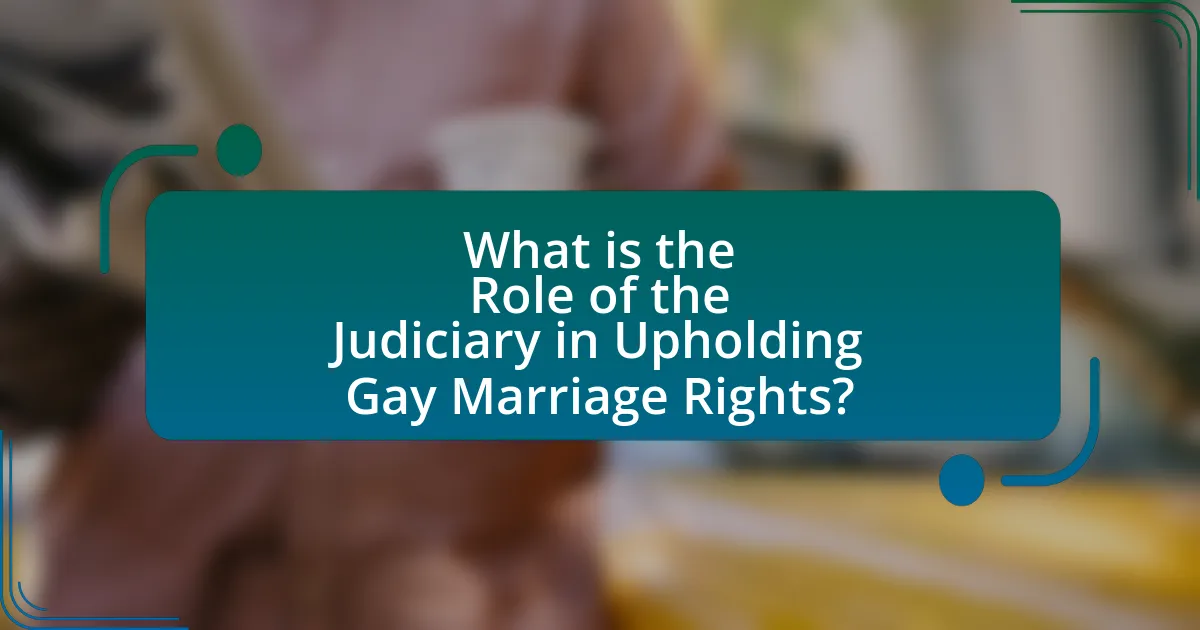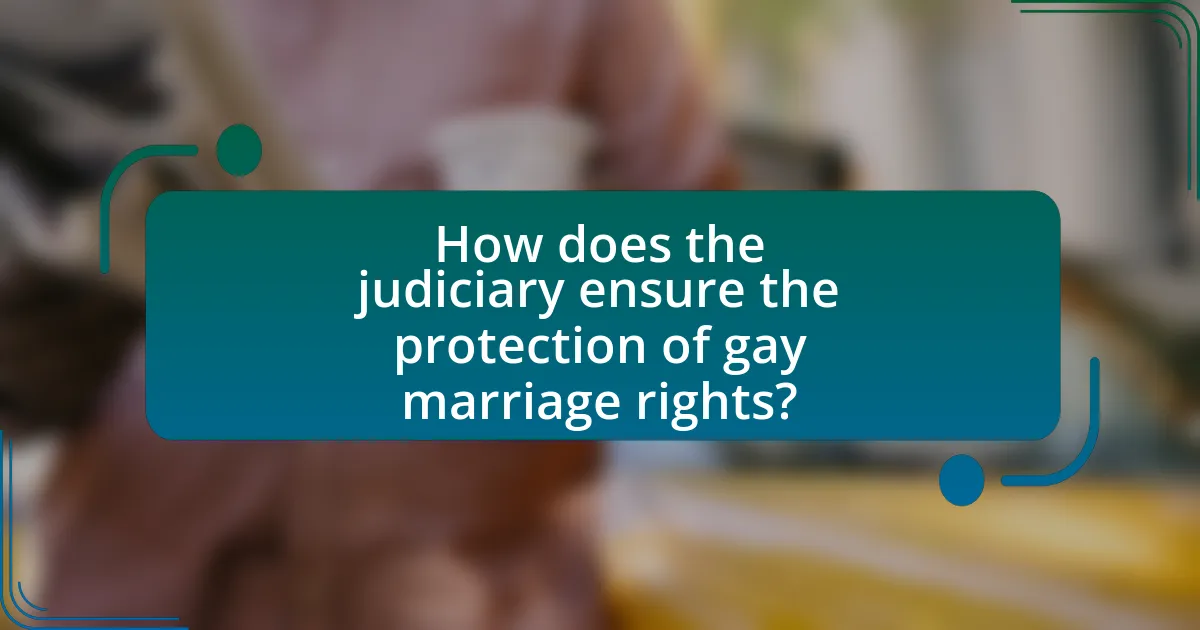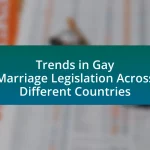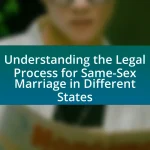The judiciary plays a vital role in upholding gay marriage rights by interpreting and enforcing laws that protect the rights of same-sex couples. Landmark cases such as Obergefell v. Hodges and United States v. Windsor have established marriage equality as a constitutional right under the Fourteenth Amendment, invalidating discriminatory laws and reinforcing the principle of equal protection. The article explores how judicial interpretations influence the legalization of gay marriage, the historical context of civil rights, and the challenges faced by the judiciary in maintaining these rights amidst societal opposition. Additionally, it examines the impact of public opinion and media on judicial decisions, as well as strategies for advocacy groups to engage with the judiciary effectively.

What is the Role of the Judiciary in Upholding Gay Marriage Rights?
The judiciary plays a crucial role in upholding gay marriage rights by interpreting and enforcing laws that protect the rights of same-sex couples. Courts have been instrumental in striking down discriminatory laws and recognizing the constitutional right to marry for all individuals, regardless of sexual orientation. For instance, the landmark Supreme Court case Obergefell v. Hodges in 2015 established that same-sex marriage is a constitutional right under the Fourteenth Amendment, which guarantees equal protection and due process. This ruling effectively invalidated state bans on same-sex marriage, demonstrating the judiciary’s power to shape and protect civil rights.
How has the judiciary influenced the legalization of gay marriage?
The judiciary has significantly influenced the legalization of gay marriage through landmark rulings that established marriage equality as a constitutional right. Notably, the Supreme Court’s decision in Obergefell v. Hodges in 2015 ruled that state bans on same-sex marriage violated the Fourteenth Amendment’s guarantees of equal protection and due process, effectively legalizing gay marriage nationwide. This ruling was based on the recognition that the right to marry is a fundamental liberty, and it built upon earlier cases, such as United States v. Windsor in 2013, which struck down the Defense of Marriage Act, affirming that the federal government must recognize same-sex marriages. These judicial decisions have set legal precedents that have shaped public policy and societal acceptance of gay marriage across the United States.
What landmark cases have shaped gay marriage rights?
The landmark cases that have shaped gay marriage rights include Obergefell v. Hodges, United States v. Windsor, and Lawrence v. Texas. Obergefell v. Hodges, decided in 2015, established that same-sex marriage is a constitutional right under the Fourteenth Amendment, effectively legalizing it nationwide. United States v. Windsor, decided in 2013, struck down key provisions of the Defense of Marriage Act (DOMA), affirming that the federal government must recognize same-sex marriages performed in states where they are legal. Lawrence v. Texas, decided in 2003, decriminalized same-sex sexual activity, which laid the groundwork for later marriage equality cases by affirming the rights of LGBTQ+ individuals. These cases collectively advanced the legal recognition and protection of same-sex marriage in the United States.
How do judicial interpretations of the Constitution affect gay marriage?
Judicial interpretations of the Constitution significantly affect gay marriage by determining the legality and recognition of same-sex unions. The landmark Supreme Court case Obergefell v. Hodges (2015) ruled that state bans on same-sex marriage violated the Fourteenth Amendment’s guarantees of equal protection and due process, thereby legalizing gay marriage nationwide. This interpretation established a constitutional right to marry for same-sex couples, reinforcing the principle that marriage is a fundamental right protected by the Constitution. Consequently, judicial decisions shape the legal landscape for gay marriage, influencing both state laws and societal acceptance.
Why is the judiciary considered a key player in civil rights issues?
The judiciary is considered a key player in civil rights issues because it interprets and enforces laws that protect individual rights and liberties. Courts have the authority to review legislation and executive actions, ensuring they comply with constitutional protections. For instance, landmark cases such as Obergefell v. Hodges (2015) established the constitutional right to same-sex marriage, demonstrating the judiciary’s role in advancing civil rights by interpreting the Equal Protection Clause of the Fourteenth Amendment. This judicial intervention is crucial in addressing injustices and upholding the rights of marginalized groups, thereby shaping the legal landscape of civil rights in society.
What historical context supports the judiciary’s role in civil rights?
The judiciary’s role in civil rights is supported by landmark Supreme Court cases that have established legal precedents for equality and justice. Notably, the Brown v. Board of Education decision in 1954 declared racial segregation in public schools unconstitutional, setting a critical precedent for civil rights litigation. Additionally, the Loving v. Virginia case in 1967 invalidated laws prohibiting interracial marriage, reinforcing the judiciary’s function in protecting individual rights against discriminatory practices. These historical contexts illustrate how the judiciary has actively shaped civil rights by interpreting the Constitution to promote equality and dismantle systemic discrimination.
How does the judiciary balance state and federal laws regarding marriage?
The judiciary balances state and federal laws regarding marriage by interpreting the Constitution and applying legal precedents to ensure that individual rights are protected. For instance, the Supreme Court’s decision in Obergefell v. Hodges (2015) established that state bans on same-sex marriage were unconstitutional, thereby reinforcing federal law over conflicting state laws. This ruling demonstrated the judiciary’s role in harmonizing state legislation with federal constitutional principles, ensuring that all citizens have equal access to marriage rights regardless of state laws.
What challenges does the judiciary face in upholding gay marriage rights?
The judiciary faces significant challenges in upholding gay marriage rights, primarily due to varying interpretations of constitutional law and state-level resistance. Courts often encounter conflicting state laws and constitutional amendments that explicitly ban same-sex marriage, complicating the enforcement of federal rulings like Obergefell v. Hodges, which legalized gay marriage nationwide in 2015. Additionally, societal attitudes and political pressures can influence judicial decisions, leading to reluctance in addressing cases related to gay marriage rights. For instance, some judges may fear backlash from constituents or political figures, which can hinder their willingness to rule in favor of same-sex marriage.
What opposition exists against judicial rulings on gay marriage?
Opposition against judicial rulings on gay marriage primarily comes from religious groups and conservative political organizations. These entities argue that such rulings undermine traditional marriage, which they define as a union between one man and one woman. For instance, the U.S. Conference of Catholic Bishops has consistently opposed same-sex marriage, citing religious beliefs that view marriage as a sacred institution meant for procreation and family structure. Additionally, some state legislatures have attempted to pass laws that restrict or nullify judicial decisions on gay marriage, reflecting a broader societal divide on the issue. This opposition is often rooted in cultural, moral, and legal arguments that challenge the legitimacy of judicial interpretations favoring gay marriage rights.
How do public opinions influence judicial decisions on gay marriage?
Public opinions significantly influence judicial decisions on gay marriage by shaping the legal landscape and prompting courts to consider societal values. For instance, as public support for gay marriage increased, evidenced by a 2015 Gallup poll showing 60% approval among Americans, courts became more inclined to rule in favor of marriage equality. This shift in public sentiment was reflected in landmark cases such as Obergefell v. Hodges, where the Supreme Court recognized same-sex marriage as a constitutional right, indicating that judicial decisions often align with prevailing public attitudes to maintain legitimacy and social cohesion.

How does the judiciary ensure the protection of gay marriage rights?
The judiciary ensures the protection of gay marriage rights primarily through the interpretation and application of constitutional principles, particularly the Equal Protection Clause and the Due Process Clause of the Fourteenth Amendment. Landmark rulings, such as Obergefell v. Hodges in 2015, established that same-sex couples have the constitutional right to marry, thereby invalidating state bans on same-sex marriage. This decision reinforced the legal precedent that marriage is a fundamental right, ensuring that all individuals, regardless of sexual orientation, are afforded the same legal protections and recognition under the law.
What legal frameworks support the judiciary’s role in gay marriage?
The legal frameworks that support the judiciary’s role in gay marriage include constitutional provisions, federal laws, and landmark court rulings. The U.S. Constitution’s Equal Protection Clause, as interpreted by the Supreme Court, mandates that states cannot deny same-sex couples the right to marry, as established in Obergefell v. Hodges (2015). This ruling invalidated state bans on same-sex marriage, reinforcing the judiciary’s authority to protect marriage equality under the law. Additionally, the Defense of Marriage Act (DOMA) was struck down in United States v. Windsor (2013), further solidifying the judiciary’s role in recognizing and upholding the rights of same-sex couples. These legal frameworks collectively empower the judiciary to ensure that gay marriage rights are upheld and protected across jurisdictions.
What statutes and amendments are relevant to gay marriage rights?
The statutes and amendments relevant to gay marriage rights include the Defense of Marriage Act (DOMA) and the Obergefell v. Hodges decision. DOMA, enacted in 1996, defined marriage for federal purposes as the union between one man and one woman, which was partially struck down by the Supreme Court in United States v. Windsor in 2013, allowing federal recognition of same-sex marriages. The Obergefell v. Hodges ruling in 2015 established that same-sex marriage is a constitutional right under the Fourteenth Amendment, affirming that states cannot deny marriage licenses to same-sex couples. These legal frameworks have significantly shaped the landscape of marriage equality in the United States.
How do precedents set by previous cases impact current rulings?
Precedents set by previous cases significantly impact current rulings by establishing legal standards and interpretations that courts are obliged to follow. This principle, known as stare decisis, ensures consistency and predictability in the law, allowing judges to rely on established rulings when making decisions in similar cases. For example, the U.S. Supreme Court’s decision in Obergefell v. Hodges (2015), which legalized same-sex marriage nationwide, was influenced by earlier rulings that recognized the rights of individuals to marry regardless of gender, such as Loving v. Virginia (1967), which invalidated laws prohibiting interracial marriage. These precedents create a legal framework that shapes the judiciary’s approach to new cases, reinforcing the protection of rights and liberties over time.
How does the judiciary respond to challenges against gay marriage rights?
The judiciary responds to challenges against gay marriage rights by interpreting constitutional principles and legal precedents to uphold or deny such rights. Courts often rely on landmark rulings, such as Obergefell v. Hodges (2015), which established that same-sex marriage is a constitutional right under the Fourteenth Amendment, ensuring equal protection and due process. This decision has set a legal standard that influences how lower courts handle subsequent cases challenging gay marriage rights, reinforcing the judiciary’s role in protecting these rights against discriminatory laws and practices.
What processes are involved in appealing judicial decisions on gay marriage?
The processes involved in appealing judicial decisions on gay marriage include filing a notice of appeal, preparing the appellate brief, and presenting oral arguments before the appellate court. The notice of appeal must be submitted within a specified timeframe after the original ruling, typically 30 days, to initiate the appeal. The appellate brief outlines the legal arguments and precedents supporting the appeal, while the oral arguments allow attorneys to present their case and answer questions from the judges. These steps are governed by specific rules and procedures set forth by the appellate court system, ensuring that the appeal is conducted fairly and in accordance with the law.
How do lower courts contribute to the evolution of gay marriage rights?
Lower courts significantly contribute to the evolution of gay marriage rights by interpreting and applying constitutional principles that support equality and non-discrimination. For instance, various state and federal lower court rulings have challenged existing laws that prohibit same-sex marriage, citing violations of the Equal Protection Clause and Due Process Clause of the Fourteenth Amendment. A notable example is the 2013 case of United States v. Windsor, where the Second Circuit Court of Appeals ruled that the Defense of Marriage Act (DOMA) was unconstitutional, setting a precedent that influenced subsequent rulings across the country. These decisions have paved the way for broader acceptance and legalization of same-sex marriage, culminating in the landmark Supreme Court decision in Obergefell v. Hodges in 2015, which affirmed the right to marry for same-sex couples nationwide.

What are the implications of judicial rulings on gay marriage rights?
Judicial rulings on gay marriage rights have significant implications for legal recognition, social acceptance, and equality. These rulings, such as the landmark Supreme Court decision in Obergefell v. Hodges (2015), which legalized same-sex marriage nationwide, establish a legal framework that protects the rights of same-sex couples to marry, thereby affirming their status under the law. This legal recognition not only provides access to various benefits, such as tax advantages and inheritance rights, but also promotes broader societal acceptance of LGBTQ+ individuals. Furthermore, judicial decisions can influence public policy and inspire legislative changes, reinforcing the principle of equality enshrined in the Constitution. The ongoing legal battles and rulings continue to shape the landscape of marriage rights, impacting both individual lives and societal norms.
How do judicial decisions affect societal attitudes towards gay marriage?
Judicial decisions significantly influence societal attitudes towards gay marriage by legitimizing and normalizing same-sex unions. For instance, the U.S. Supreme Court’s ruling in Obergefell v. Hodges (2015) legalized gay marriage nationwide, which led to increased acceptance and support for LGBTQ+ rights among the general public. Following this landmark decision, surveys indicated a rise in public approval of gay marriage, with a Gallup poll showing support increasing from 40% in 2008 to 70% in 2021. This demonstrates that judicial rulings can shift societal perceptions, making gay marriage more socially acceptable and integrated into mainstream culture.
What role does media play in shaping public perception of judicial rulings?
Media plays a crucial role in shaping public perception of judicial rulings by influencing how information is presented and interpreted. Through coverage of court cases, media outlets highlight specific aspects of rulings, often framing them in a way that resonates with public sentiment. For instance, during the Supreme Court’s decision on Obergefell v. Hodges, which legalized same-sex marriage nationwide, media narratives emphasized themes of equality and civil rights, significantly swaying public opinion in favor of the ruling. Studies indicate that media framing can lead to increased public support for judicial decisions, as seen in various surveys conducted around major rulings, where positive media portrayal correlates with higher approval ratings for the judiciary.
How do judicial outcomes influence legislative actions regarding marriage rights?
Judicial outcomes significantly influence legislative actions regarding marriage rights by establishing legal precedents that lawmakers must consider. For instance, the U.S. Supreme Court’s decision in Obergefell v. Hodges (2015) legalized same-sex marriage nationwide, prompting state legislatures to align their laws with this ruling. This judicial mandate often leads to the repeal of discriminatory laws and the introduction of new legislation that protects marriage rights for all couples. Additionally, judicial rulings can mobilize public opinion and advocacy efforts, further pressuring legislators to enact inclusive policies.
What best practices can be adopted to support the judiciary in upholding gay marriage rights?
To support the judiciary in upholding gay marriage rights, best practices include implementing comprehensive legal training for judges on LGBTQ+ rights and equality. This training should focus on the historical context of discrimination against LGBTQ+ individuals and the legal precedents that affirm marriage equality, such as the U.S. Supreme Court’s decision in Obergefell v. Hodges (2015), which established that same-sex couples have the constitutional right to marry. Additionally, establishing clear guidelines and protocols for handling cases related to gay marriage can ensure consistency and fairness in judicial decisions. Engaging with LGBTQ+ advocacy organizations can also provide judges with resources and insights that enhance their understanding of the community’s needs and rights.
How can advocacy groups effectively engage with the judiciary?
Advocacy groups can effectively engage with the judiciary by utilizing strategic litigation, amicus curiae briefs, and public education campaigns. Strategic litigation involves selecting cases that can set important legal precedents, thereby influencing future judicial decisions related to gay marriage rights. For instance, the case of Obergefell v. Hodges in 2015, where advocacy groups played a crucial role, resulted in the Supreme Court recognizing same-sex marriage as a constitutional right.
Additionally, submitting amicus curiae briefs allows advocacy groups to present relevant information and perspectives to the court, which can aid judges in understanding the broader implications of their rulings. The Human Rights Campaign has frequently employed this tactic to support cases that align with their mission.
Public education campaigns also serve to raise awareness and mobilize community support, which can indirectly influence judicial outcomes by demonstrating public backing for gay marriage rights. Research indicates that increased public support can lead to more favorable judicial decisions, as seen in various rulings across different jurisdictions.
What strategies can be employed to educate the public about judicial roles in marriage rights?
To educate the public about judicial roles in marriage rights, strategies such as community workshops, informational campaigns, and partnerships with advocacy organizations can be employed. Community workshops can provide direct engagement, allowing legal experts to explain judicial processes and landmark cases, such as Obergefell v. Hodges, which legalized same-sex marriage in the U.S. Informational campaigns utilizing social media and traditional media can disseminate clear, factual information about the judiciary’s impact on marriage rights. Collaborating with advocacy organizations can amplify outreach efforts, leveraging their networks to reach diverse audiences and foster discussions about the importance of judicial decisions in protecting marriage rights.


